| Columns Retired Columns & Blogs |
Does the PM5003 have sub/lfe-in? This Amp is perfect for my price range, but subwoofer compatibility is a HUGE selling point for me...
I examined the Marantz PM5003's measured behavior using Stereophile's loan sample of the Audio Precision SYS2722 system (see the January 2008 "As We See It" and www.ap.com); for some tests, I also used my vintage Audio Precision System One Dual Domain.
Before I test an amplifier, I run it for 60 minutes at one-third its specified power into 8 ohms. Thermally, this is the worst case for an amplifier with a class-B or -AB output stage. At the end of this period, the Marantz's case was warm to the touch and the grille above its internal heatsink was too hot to touch. Even so, the amplifier's heatsinking is adequate for its power level.
Looking first at the moving-magnet phono input, this offered an appropriate 38.5dB of gain, measured at the Tape Out jacks, and preserved absolute polarity (ie, was non-inverting). The input impedance was 48k ohms over most of the audioband, dropping slightly to 40k ohms at 20kHz. The RIAA correction, again measured at the Tape Out jacks, was superbly flat in the right channel (fig.1, red trace), but less good in the left (blue trace), with a –0.26dB shelf in the treble, presumably due to a slightly out-of-tolerance resistor or capacitor. The wideband signal/noise ratio (ref. 5mV input at 1kHz) was a good 57dB, this increasing to 81.2dB when A-weighted, which is only just below specification. The phono amplifier had excellent overload characteristics, offering 27dB of margin at all frequencies.
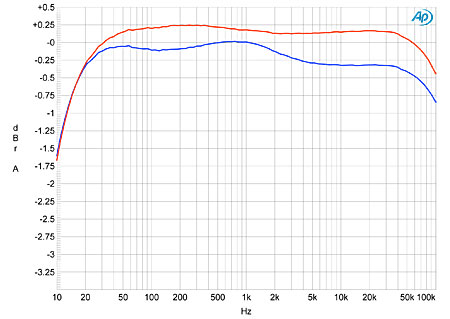
Fig.1 Marantz PM5003, RIAA error of MM phono input (left channel blue, right red; 0.25dB/vertical div.).
The Marantz's line inputs can be operated with the tone controls in-circuit or bypassed; Marantz calls the latter mode Source Direct. The maximum voltage gain was the same in both modes of operation, at 37.9dB into 8 ohms, and both modes were non-inverting. The input impedance was the same in both modes, at 24k ohms across the audioband, which is insignificantly higher than the specified figure of 20k ohms.
The PM5003's output impedance was fairly low, at 0.1 ohm at low and middle frequencies, rising inconsequentially to 0.12 ohm at the top of the audioband. As a result, the modification of the amplifier's response driving our standard simulated loudspeaker (fig.2, gray trace) held to within limits of ±0.15dB. However, this graph also shows a 0.3dB channel imbalance in favor of the right channel (red and magenta traces). The volume control was set to 2:00 for these measurements; rotating the control clockwise to its maximum setting reduced the imbalance to 0.1dB, now in favor of the left channel.
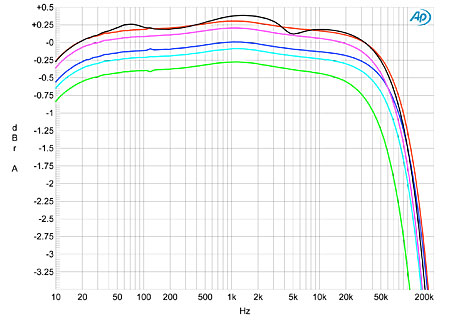
Fig.2 Marantz PM5003, Source Direct frequency response at 2.83V into: simulated loudspeaker load (gray), 8 ohms (left channel blue, right red), 4 ohms (left cyan, right magenta), 2 ohms (green). (0.25dB/vertical div.)
The set of curves in fig.2 was taken in Source Direct mode (ie, with the tone controls bypassed), yet a slight (0.25dB) boost can be seen in the upper midrange that will be just audible. The amplifier performed identically with the tone controls in-circuit but set to their detented, flat positions, so this behavior is not due to residual tone-control equalization. The PM5003 has a wide small-signal bandwidth in Source Direct mode, with a –3dB point of 140kHz, which correlates with a well-shaped 10kHz squarewave response (fig.3). However, setting the volume control to its maximum position increased the upper –3dB point to well above 200kHz, while switching in the tone controls reduced this to 110kHz, and gave a very slightly earlier low-frequency rolloff (not shown).

Fig.3 Marantz PM5003, Source Direct small-signal 10kHz squarewave into 8 ohms.
Fig.4 shows the effect of the treble and bass controls set to their maximum and minimum positions, as well as to their central detented positions. (The measurements were taken at 1V output, to avoid clipping the output stage at extreme control settings.) The maximum treble boost and cut was ±10dB at 15kHz, and the bass figures were ±11dB at 75Hz; both sets are appropriately modest. Channel separation at 1kHz was good at 90dB L–R and 80dB R–L, but it decreased to 70dB in both directions at 100Hz, and to 62dB L–R and 56dB R–L at 20kHz, the latter due to the usual capacitive coupling. The wideband, unweighted S/N ratio (ref. 1W into 8 ohms with the input shorted but the volume control set to its maximum) was the same in both tone-control and Source Direct modes, at 68dB. Restricting the measurement bandwidth to the audioband improved the ratio to an excellent 86.5dB, which is basically to specification.

Fig.4 Marantz PM5003, frequency response at 1V into 8 ohms with treble and bass controls set to maximum and minimum positions (left channel blue, right red; 1dB/vertical div.).
With both channels active, the Marantz PM5003 met its specified maximum output powers of 40Wpc into 8 ohms (16dBW) and 55Wpc into 4 ohms (14.4dBW). At clipping (defined as 1% THD in the output signal), the PM5003 delivered 42Wpc into 8 ohms (16.2dBW) and 58Wpc into 4 ohms (14.6dBW). (I didn't test the amplifier's power delivery into 2 ohms.) Fig.5 shows how the THD+noise percentage in the amplifier's output changed with output power into 8 and 4 ohms; the downward slope of the traces below 20–30W suggests that the actual distortion present was below the noise floor, and the onset of actual waveform clipping is quite sudden. This graph was taken with the tone controls in-circuit but set to their flat positions. Though the clipping power was identical into both loads, to my surprise the amplifier behaved quite differently at lower powers in Source Direct mode (fig.6). The THD+N is the same as in fig.6, until 1.3W into 8 ohms and 2.6W into 4 ohms (both equivalent to an output voltage of 3.2V RMS), when there is a sudden, drastic rise in THD to just over 0.3%. This then drops a little before the amplifier reaches its actual clipping point.

Fig.5 Marantz PM5003, tone controls in-circuit but set to flat, distortion (%) vs 1kHz continuous output power into (from bottom to top): 8, 4 ohms.

Fig.6 Marantz PM5003, Source Direct, distortion (%) vs 1kHz continuous output power into (from bottom to top below 1W): 8, 4 ohms.

Fig.7 Marantz PM5003, tone controls in-circuit but set to flat, THD+N (%) vs frequency at 2.83V into: 8 ohms (left channel blue, right red), 4 ohms (left cyan, right magenta).
This disparity between the two modes can also be seen in the graphs plotting THD+N against frequency at 2.83V (fig.7 with tone controls active, fig.8 in Source Direct mode). With the tone controls operating (fig.7), the THD is below the noise at frequencies below 1.5kHz or so, as predicted from fig.5; it does rise at higher frequencies due to the usual decrease in open-loop bandwidth, though this is not to any significant level, even into lower impedances. In Source Direct mode (fig.8), however, the distortion remains quite high over most of the audioband and comprises many low-order harmonics (fig.9). By contrast, the distortion waveform with tone controls active at the same power level (fig.10) is mainly second-harmonic in nature, though the spikes at the signal's zero-crossing points suggest insufficient bias current for the output-stage transistors.

Fig.8 Marantz PM5003, Source Direct, THD+N (%) vs frequency at 2.83V into: 8 ohms (left channel blue, right red), 4 ohms (left cyan, right magenta).
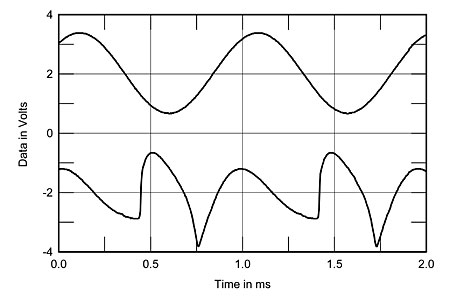
Fig.9 Marantz PM5003, Source Direct, 1kHz waveform at 5.4W into 8 ohms (top), 0.31% THD+N; distortion and noise waveform with fundamental notched out (bottom, not to scale).
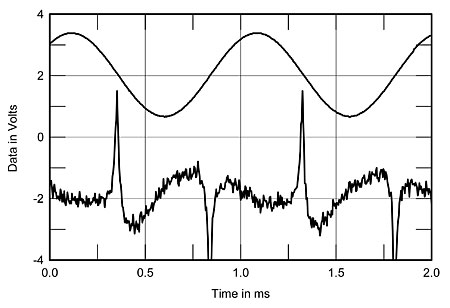
Fig.10 Marantz PM5003, tone controls in-circuit but set to flat, 1kHz waveform at 5.4W into 8 ohms (top), 0.007% THD+N; distortion and noise waveform with fundamental notched out (bottom, not to scale).
At power close to clipping, the third harmonic becomes the highest in level in tone-control mode (fig.11), while the second harmonic is highest in Source Direct (fig.12); although a regular series of higher harmonics can be seen in both modes, these are much higher in level in Source Direct. While the 120Hz power-supply hum component in these two graphs is respectably low in both modes, at –103dB left and –95dB right, the 1kHz fundamental and the harmonics each acquire a pair of sidebands at ±120Hz in Source Direct (fig.12). The PM5003 did well in the demanding high-frequency intermodulation test, at a power level just below visible waveform clipping on the oscilloscope (fig.13). All the intermodulation products were at or below –96dB (0.0015%). This was with the tone controls active, however. In Source Direct mode at the same power level (not shown), the 1kHz difference component rose from –100dB (0.001%) to –60dB (0.1%).
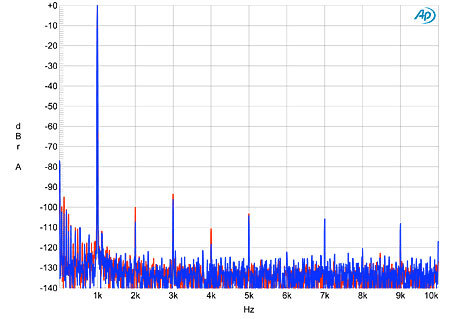
Fig.11 Marantz PM5003, tone controls in-circuit but set to flat, spectrum of 1kHz sinewave, DC–10kHz, at 27W into 8 ohms (left channel blue, right red; linear frequency scale).

Fig.12 Marantz PM5003, Source Direct, spectrum of 1kHz sinewave, DC–10kHz, at 27W into 8 ohms (left channel blue, right red; linear frequency scale).

Fig.13 Marantz PM5003, tone controls in-circuit but set to flat, HF intermodulation spectrum, DC–24kHz, 19+20kHz at 22W peak into 8 ohms (linear frequency scale).
Bob Reina reports hearing no difference between Source Direct mode and the active but centered tone controls. But its measured performance does indicate that the Marantz PM5003 was not working properly in Source Direct; perhaps something broke in shipping or when I hooked up the amplifier on the testbench, though it's odd that both channels were affected. But assuming that the PM5003's measured performance with tone controls active is indicative of its intrinsic performance, it did well for such an inexpensive amplifier. I was worried about the lack of output-stage bias, but the excellent MM phono stage is a bonus.—John Atkinson

Does the PM5003 have sub/lfe-in? This Amp is perfect for my price range, but subwoofer compatibility is a HUGE selling point for me...

Love this amp. Picked it up today (where it was on sale for $100 off the $449 list price--nice surprise!). I'm replacing an old Yamaha A1020, purchased new in 1986 and which has been developing "issues." I was a little apprehensive about going from 125 watts/channel to 40, but my original Advent Loudspeakers love this thing! While I miss some of the more sophisticated controls of the old Yamaha (the bass and treble fine-tuning controls were, well, more fine-tuning; there was a mono switch; and Yamaha does variable loudness knobs so good), but I am also really enjoying the simplicity of this unit--and the excellent sound. And I was really pleasantly surprised by the quality of the phono input, which is just as good or better than the input on the old Yamaha.

Love this amp. Picked it up today (this year's model, the PM5004, at one of your better known electronics mall stores where it was on sale for $100 off the $449 list price--nice surprise!). I'm replacing an old Yamaha A1020, purchased new in 1986 and which has been developing "issues." I was a little apprehensive about going from 125 watts/channel to 40, but my original Advent Loudspeakers love this thing! I miss some of the more sophisticated controls of the old Yamaha (the bass and treble fine-tuning controls were, well, more fine-tuning; there was a mono switch; and Yamaha does variable loudness knobs so good), but I am also really enjoying the simplicity of this unit--and the excellent sound. And I was really pleasantly surprised by the quality of the phono input, which is just as good or better than the input on the old Yamaha.
So far I've auditioned Kind of Blue on an early pressing, and side 3 of the blue Beatles album, and was very impressed with the distinction of the bass and the clarity of the mid-range and highs. While those highs don't extend quite the way they did with the Yamaha, I also have an amp that, for under 400 bucks, is giving me the kind of solid, focused sound stage that my old Yamaha, in its better days, used to deliver.
I also auditioned recorded tapes (home tapes of my LPs) through both my Nak CR-3a and Denon DRM 500, and both sound sources came through as nice sounding as I've ever heard them on my system.
I anticipate many years of audio bliss with this amp.